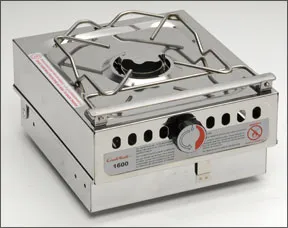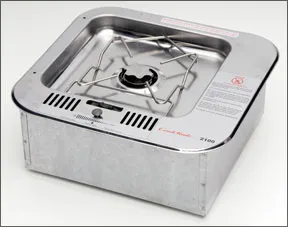Cookmates two new small alcohol stoves are a good fit for daysailers and boats with limited galley space. Unlike propane stoves, these non-pressurized alcohol systems require no valves, hoses, fuel tanks, or fuel lockers. The alcohol is easily poured into a stainless steel drum. Opening the burner allows for easy lighting of the stove. Methane, ethanol, and denatured alcohol can be used as a fuel source. The Cookmate 2100 drop-in model is made of stainless steel and puts out 7000 BTUs. It is well made and easy to use, but because it cannot be gimbaled, its use may be limited in rough seas. The CookMate 1600, designed as a portable countertop model, is also small and well made, and it can be gimbaled. It is made of stainless steel and puts out 7000 BTUs. Both Cookmate alcohol stoves beat the Origo alcohol stoves Practical Sailor tested in July 2006, and they gave the Force 10 Seacook seaswing style propane stove and Kenyon Appliances Kenyon Express II butane stove a run for their money.
****
Although small stoves lack the fuel capacity for full-duty on an extended cruise, theyre great for daysails, weekend getaways, and as a backup to a primary range. Any onboard cooking requires a stove that is easy to use, reliable, durable, and safe. For small-boats, stove portability and easy stowage are essential.

In July 2006, we tested four single-burner stoves, including the Origo 1500 alcohol stove made by Dometic USA. Although the Origo was slower to boil water than its propane-fueled counterparts, we found the polished stainless-steel stove to be a well-made, seaworthy single-burner. (Read the 2006 review at www.practical-sailor.com, under “Tools & Techniques.”)
This month, we look at two new single-burner alcohol stoves similar to the Origo line: the CookMate 2100 drop-in and the CookMate 1600 portable stove, both made by Contoure International.
What We Tested
Like most of the alcohol stoves now available, the new CookMates are non-pressurized systems and require no pumping or priming. And, in contrast to propane stoves, these liquid-fueled stoves have no valves, hoses, fuel tanks, or ventilated propane lockers to worry about.
To fuel them, alcohol is poured into a stainless-steel fuel canister, which is then placed inside the stove. The cook simply opens the stovetops burner by turning the flame adjustment knob and lights the alcohol using a handheld butane lighter or other long, grill-style lighter.
Methanol, ethanol, or denatured alcohol will fuel the stoves. CookMate recommends “Soot Free” alcohol.
How We Tested
Following the same protocol as the 2006 evaluation, Practical Sailor testers used a digital thermocouple to determine how quickly each stove could boil 2 cups of tap water to 212 degrees in a standard 7-inch pot and how well they could hold a simmer, 140 to 160 degrees.
The CookMates were evaluated on quality of construction and features like spill-pan depth, pot holders, and control-knob ergonomics. Testers also checked compliance with the American Boat and Yacht Council (ABYC)s standards for galley stoves. To satisfy ABYC standards, liquid-fueled stoves must have properly displayed warnings and instructions, a -inch or deeper spill pan, and a means to keep cookware in place on a heel, among other things. They must also be able to operate at a 30-degree incline without risk of fuel spillage or injury.

To test ease of cleaning, we spattered hot, sugary oatmeal on the stoves, let it cook, and left it to harden for a few days before cleaning it off with soap and water on a non-abrasive sponge. We also sprayed the stoves with salt water to determine how prone they are to corrosion.
We compared the stoves to the top performers of the 2006 test: the Budget Buy Kenyon Express II (butane), and the Recommended Origo 1500 (alcohol). Unfortunately, that tests Best Choice, the Force 10 Seacook (propane) is no longer in production.
CookMate 2100
Several features set the CookMate 2100 apart from Origo drop-in stove. It has a galvanized heat shield over the burner to help control the flame and a cool-touch burner adjuster-a silicone-coated wheel used to open and close the burner-to make flame adjustment easy and safe.
The 2100 also uses the new SafeFlame canister system. Designed for the faster absorption of fuel, the canister does not leak, even when its turned upside down. This is an important feature in rough seas, and its an ABYC requirement.
Testers found the fuel drum easy to fill and install. Made mostly of 304-grade stainless steel, the 2100 will cook for four to six hours with a full fuel canister (1.25 quarts). The stove puts out 7000 BTUs.
In Practical Sailors tests, the 2100 took between 5 and 6 minutes to boil 2 cups of tap water. Testers had no problem maintaining a simmer.
When it came to cleaning the 2100, the caked-on oatmeal wiped right off the cooktop face. However, one minor negative was that in order to remove the grill for bucket soaking, users must open the stove and pop out the grate from the inside. We recommend that the fuel canister be removed before cleaning to avoid getting water in it.
Corrosion testing yielded a small amount of oxidation on the heat shield and burner grill after several weeks. Also, the spring knob used to lift the stove face stiffened over time and needed to be lubricated.
The stove ships with a bamboo cutting board that fits into the stovetop recess, a nice feature. Potholders, however, are not standard. The optional hardware is necessary to keep pots and pans from sliding off the stove and to meet ABYC standards.
One drawback to drop-in stoves is that they cannot be gimbaled, which limits the conditions when the stove can be used.
Bottom line:
The CookMate 2100 is simple and easy to use. It is a quality stove but as with all built-in cooktops, its usefulness is limited in rough seas.
CookMate 1600
The CookMate 1600 is smaller than the 2100 and is designed as a countertop model. Its identical in weight, dimensions, and ergonomics to the Origo 1500 we tested previously.
Its small enough to be portable and can be fitted with the optional pot holders. Unlike the 2100, however, it can be gimbaled with the optional hardware. This makes the CookMate 1600, like the Origo 1500, ABYC compliant.
The 1600 has the same heat shield, cool-touch knob, and easy-to-use SafeFlame fuel system as the 2100. Its quality construction is also the same with a 304-grade stainless body, as are its BTU rating and cooktime.
One difference was performance. The 1600 boiled water slightly faster than the 2100 in our tests: On average, it heated the water to 212 degrees in 4 to 5 minutes and easily maintained a simmer. The 1600 also is easier to clean than the 2100 as its grill grate pops off easily.
Bottom line:
The CookMate 1600 is well-made and easy to use. This compact unit is a good choice for boats short on space and boaters who prize simplicity.
Conclusion
Both stoves beat the Origo 1500 we tested in July 2006 in the boil tests. Their boil times, in fact, were in line with the propane-fueled Force 10 Seacook (6 minutes, 9 seconds) and the butane-powered Kenyon Express II (4 minutes, 20 seconds). However, they cost more than twice the Kenyon Express II ($42). The Origo 1500 can be found for the same price as the CookMate 1600.
Among small alcohol-fueled stoves, we call a draw. The CookMates offer some updated features and design improvements, but Origo is a well-established brand known for its good customer service. We have no reason to expect any less from Contoure, but the stoves are new products.
No one dislikes inconclusive tests more than Practical Sailor editors, but in the case of CookMate vs. Origo, its a tie.





































